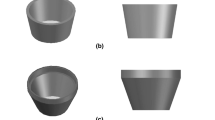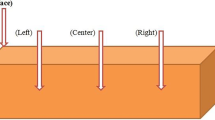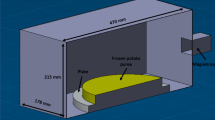Abstract
A simple analytical heat flow model for a closed rectangular food package containing fruits or vegetables is proposed for predicting time temperature distribution during transient cooling in a controlled environment cold room. It is based on the assumption of only conductive heat transfer inside a closed food package with effective thermal properties, and convective and radiative heat transfer at the outside of the package. The effective thermal conductivity of the food package is determined by evaluating its effective thermal resistance to heat conduction in the packages. Food packages both as an infinite slab and a finite slab have been investigated. The finite slab solution has been obtained as the product of three infinite slab solutions describe in ASHRAE guide and data book. Time temperature variation has been determined and is presented graphically. The cooling rate and the half cooling time were also obtained. These predicted values, are compared with the experimentally measured values for both the finite and infinite closed packages containing oranges. An excellent agreement between them validated the simple proposed model.










Similar content being viewed by others
References
Abdul M (1988) Prediction of air-cooling characteristics of moist food. Trans ASAE 23(3):788–792
Ansari FA, Charan V, Varma HK (1983) Estimation of thermal conductivity of food product along with surface heat transfer coefficient. Paper No. B1/56, XVI Int. Congress Refrig., Paris, August 31–Sept. 71
Ansari FA, Charan V, Varma HK (1984) Thermo physical properties of fruits and vegetables of India origin. Inst Engrs India J1(1):113–115
ASHRAE (1978) Guide and Data Book Application, 1978, Published by the ASHRAE. Inc. Georgia, Atlanta
Bennet AH (1964) Precooling of fruits and vegetables. Trans ASAE 7:265–270
Bhowmik SR (1979) A new method for determining the apparent thermal diffusivity of thermally conductive food. J Food Sci 44(2):469–474
Castillo PF, Barreiro JA, Salas GR (1983) Prediction of nutrient retention in thermally processed heat conduction food packed in restorable pouches. J Food Sci 45:1513–1516
Dincer I (1993) Methodology to determine temperature distribution in cylindrical product exposed to hydro cooling. Int Commer Heat Mass Transf 19:359–371
Gaffney JJ, Baird CD, Chau KV (1985) Method for calculating heat and mass transfer in fruits and vegetables individually and in bulk. ASHRAE Trans 1(Part 2B):332–352
Hayakawa KI (1973) A new method for the computerized development of the apparent thermal diffusivity of food. First Pacific Chemical Eng. Congress. Part II, 129–140
Hayakawa K, Bakal A (1983) New computational procedure for determining the apparent thermal diffusivity of a solid body approximated with an infinite slab. J Food Sci 38:623–629
Incropera FP (1981) Fundamental of heat transfer. John Wiley & Sons, New York
Isachenko V (1977) A heat transfer. Mir Publisher, Moscow
Hick EW (1955) Precooling of fruits and vegetables, some theoretical consideration. Proc. 9th Int. Congr. Refrig. Paris 1, pp 1–11
McAdams WH (1954) Heat transmission. McGraw-Hill Book Company, Inc, New York
Mannapperuma JD, Singh RP (1989) Computer-aided method for the prediction of properties and freezing & thawing times of foods. J Food Eng 9(4):275–304
Mattea M (1986) Prediction of thermal conductivity of vegetable foods by effective medium theory. Journal of Food Science 51(1):113–115
Mincer BC, Shove GC (1988) Simulated cooling of potatoes. Trans ASAE 19(5):945–951
Mohsenin NN (1980) Thermal properties of food and agricultural materials. Gordon and Breach Science, New York
NarasimhaRao KV, Narasimham GSVL, Krishna Murthy MV (1993) Analysis of heat and mass transfer in bulk hydro cooling of spherical food products. Int J Heat Mass Transf 36(3):809–812
Nasvadha P (1989) Microcomputer prediction of temperature in foods. J High Temp High Press 21(3):325–328
Pan JC, Bhownic SR (1993) The finite element of transient heat transfer in fresh tomatoes during cooling. Trans ASAE 34(3):3903–3906
Progethof RC, Throne JL, Ruetsch RR (1976) Methods for predicting the thermal conductivity of composite system—a review. Polym Eng Sci 16:615–617
Raval AH, Solanki SC, Verma HK (1994) Heat transfer analysis in forced air-cooling of spherical food produces. Proc. of IX.ISME Conference on Mech. Engg, Nov. 11–12 pp. 287–292
Yagi S, Kunij D (1957) Studies on effective thermal conductivity in packed beds. AIChE J 3(3):373–381
Author information
Authors and Affiliations
Corresponding author
Rights and permissions
About this article
Cite this article
Raval, A.H., Solanki, S.C. & Yadav, R. A simplified heat transfer model for predicting temperature change inside food package kept in cold room. J Food Sci Technol 50, 257–265 (2013). https://doi.org/10.1007/s13197-011-0342-z
Revised:
Accepted:
Published:
Issue Date:
DOI: https://doi.org/10.1007/s13197-011-0342-z




